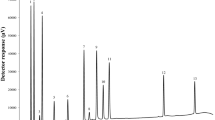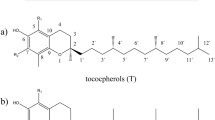Summary
A method for the quantitative determination of vitamin B6 in food by using high-pressure liquid chromatography and a fluorescence detector is described. The analytical method measures any vitamin B6 compound present in food (pyridoxamine, pyridoxal, pyridoxine and their phosphoric acid esters).
Pyridoxamine (PM), pyridoxal (PL) and pyridoxine (PN) are released from the food after 30 min hydrolysis with 0.2N-sulfuric acid at 120°C. The filtered extract is applied directly to a reversed phase Spherisorb ODS column. PM, PL and PN are separated as mobile phase by using 0.08N-sulfuric acid and measured by means of the fluorescence detector (excitation: 290 nm, emission: 395 nm). Recovery rates of PM, PL and PN added to the samples were between 94 and 102% depending on the kind of food. The detection limit is 5 μg PM and 10 μg PL or PN, resp. per 100 g food. The analytical procedure is simple, specific and has many applications; the results are well reproducible.
Zusammenfassung
Eine Methode zur quantitativen Bestimmung von Vitamin B6 in Lebensmitteln mittels Hochdruck-Flüssig-Chromatographie und eines Fluorescenzdetektors wird beschrieben. Durch das Analysenverfahren werden sämtliche in den Lebensmitteln vorkommenden Vitamin-B6-Verbindungen (Pyridoxamin, Pyridoxal, Pyridoxin und deren Phosphorsäureester) erfaßt.
Aus den Lebensmitteln werden Pyridoxamin (PM), Pyridoxal (PL) und Pyridoxin (PN) durch Hydrolyse mit 0,2n-Schwefelsäure bei 120°C nach 30 min freigesetzt. Die gefilterte Extraktlösung wird direkt auf eine reversed phase Spherisorb ODS-Säule aufgetragen und mit 0,08n-Schwefelsäure als mobile Phase PM, PL und PN abgetrennt und am Fluorescenzdetektor (Anregung: 290 nm, Emission: 395 nm) gemessen. Die Wiederfindungsraten der den Analysenproben zugesetzten PM, PL und PN lagen je nach Art der Lebensmittel zwischen 94 und 102%. Die Nachweisgrenze ist 5 μg PM und 10 μg PL bzw. PN pro 100 g Lebensmittel. Das Analysenverfahren ist vielseitig anwendbar, relativ einfach zu handhaben, wenig störanfällig und liefert gut reproduzierbare Ergebnisse.
Similar content being viewed by others
Literatur
Henessy DJ, Steinberger AM, Wilson GS, Kaeveney VP (1960) J AOAC 43:765
Vuilleumier JP, Probst HP, Brubacher G (1967) In: Handbuch der Lebensmittelchemie II/2, Springer, Berlin pp 746–748
Toepfer EW, Polansky MM (1970) J AOAC 53:564
GregoryIII JF (1980) J Agric Food Chem 28:486
GregoryIII JF (1980) J Food Sci 45:84
Evans SR, GregoryIII JF, Kirk JR (1981) J Food Sci 46:555
Lim KL, Joung RW, Driskell JA (1980) J Chromatogr 188:285
Morita E, Mizuno N (1980) J Chromatogr 202:134
Vanderslice JT, Maire CE, Doherty RF, Becher GR (1980) J Agric Food Chem 28:1145
Author information
Authors and Affiliations
Additional information
Herrn S. Dieterich danke ich für die sorgfältige Durchführung der Untersuchungen
Rights and permissions
About this article
Cite this article
Bognar, A. Bestimmung von Vitamin B6 in Lebensmitteln mit Hilfe der Hochdruckflüssig-Chromatographie (HPLC). Z Lebensm Unters Forch 181, 200–205 (1985). https://doi.org/10.1007/BF02425578
Received:
Issue Date:
DOI: https://doi.org/10.1007/BF02425578




